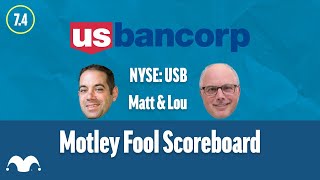
It pays to listen to U.S. Bancorp (USB +0.83%) CEO Richard Davis whenever there's an opportunity to do so. Not only does Davis lead one of the nation's most profitable banks, he's also full of prescient insights on banking. Here are five such insights from U.S. Bancorp's third-quarter conference call with analysts.
1. U.S. Bancorp is a "believer in the branch network"
Big branch networks are no longer what they used to be. Once considered the cornerstone of competitive advantage in the industry, the adoption of online and mobile banking has led many of U.S. Bancorp's competitors to prune branches in an effort to reduce expenses.
Bank of America (BAC +0.50%) serves as a case in point. Since the beginning of 2011, the Charlotte, North Carolina-based bank has shuttered over a thousand branches, or 17.5% of its once industry-leading network.
But Davis is circumspect of this trend. He noted that branches are unattractive right now in large part because interest rates are low, which reduces the value of deposits -- collecting deposits being a branch network's primary purpose. Davis believe this will change once rates increase:
[B]ranch closures look very attractive now because they're not only not very profitable, they're actually going the wrong direction as interest rates stay low and deposit values are much less than they will be in the future. But there will be a time when rates go back up, I know you and I are old enough to remember and deposits will be the governor on how many loans you can make. And that's the benefit we're always going to have on these interlopers who are coming in with these great lending ideas that don't have deposits. And we shouldn't give up the one thing we have, which is deposits, which will be the key driver.
2. Banking and baggage handlers
New rules and regulations, as well as the threat of public and private lawsuits, have left an indelible mark on the bank industry since the financial crisis. In addition to increasing costs, these forces have changed how banks approach compliance. Davis explained this by noting that all of the bank's employees have "gone from baggage handlers to pilots."
Baggage handlers, every once in a while, will make a mistake, and up until now, it's OK. No one loses their lives. But pilots of the same company can't crash a plane. I've had to move all of our employees from baggage handlers to pilots and we're still in that transition. The regulators have required that of us as well. So I am spending money on either back-office or more often than not, technology to replace some of the error-ridden places where a human interaction creates an outcome that's not acceptable anymore.
3. One-two punch on expenses
U.S. Bancorp has long been one of the most efficient banks in the country. In the third quarter, it reported a 53.9% efficiency ratio, meaning that only 53.9% of its revenue was consumed by operating expenses. For the same period, by comparison, Bank of America's efficiency ratio was 66%. And even the notoriously efficient Wells Fargo (WFC +0.88%) trails in U.S. Bancorp's wake, with an efficiency ratio of 56.7%.
|
Bank |
3Q15 Efficiency Ratio |
|---|---|
|
JPMorgan Chase (JPM +0.99%) |
67.5% |
|
Bank of America |
66% |
|
Wells Fargo |
56.7% |
|
U.S. Bancorp |
53.9% |
Data source: Quarterly earnings releases from JPMorgan Chase, Bank of America, Wells Fargo, and U.S. Bancorp.
In an attempt to further drive down expenses in response to the prevailing low-revenue environment, weighed down by near-zero-percent short-term interest rates, U.S. Bancorp had previously frozen its full-time employee (FTE) count. New employees could be hired, but only to replace ones that were leaving. The Minnesota-based bank is now taking this one step further, by attacking discretionary expenses.
According to Davis:
This is being accomplished through FTE actions as well as programs that will reduce travel costs by effectively using video and teleconferencing, increasing our use of air fare and hotel discounts and eliminating most discretionary travel. We're also expanding the use of electronic communication internally and with our customers to reduce spending in printing and postage. Additionally, we begun to evaluate professional service and contract labor arrangements, and we expect to see improved efficiencies as resources are more appropriately allocated.
4. What will happen when interest rates rise
One of the big question marks in the bank industry right now concerns the fallout from higher interest rates -- assuming, of course, that the Federal Reserve eventually decides to push them up. Davis has been one of the few big bank CEOs to discuss this issue candidly on record. As he sees it, there will be two effects: deposits will flee in search of higher yields and commercial customers were scurry at the last moment to lock in lower lending rates.
We're all going to have to get ready for this moment when deposits start to flow out of banks, and we should celebrate it, right? [Customers] are back up to a savings level now that hasn't been seen in 12 years. That's great for America, but now we want them to use [their deposits]. [...] Secondly, lines of credit that are already extended but not used -- get used, and then eventually new lines and loans start to happen. That's how the cycle reverses itself.
5. Timeline for future acquisitions
If bankers learned anything from the financial crisis, it was to be more judicious with acquisitions. Bank of America discovered this the hard way, with its 2008 purchase of mortgage-originator-cum-criminal enterprise Countrywide Financial, which has cost the bank $100 billion or more in subsequent legal fines and expenses. To a lesser extent, JPMorgan Chase learned the same lesson from its government-assisted acquisitions of Bear Stearns and Washington Mutual.
U.S. Bancorp avoided these pitfalls and is intent on continuing to do so. In response to an analyst's question about acquisitions, Davis explained that U.S. Bancorp won't be buying banks until at least 2017, at which point the statute of limitations should have run on crisis-related legal claims that could be brought against potential acquisition targets.
I think the statute in our head kind of ends in '17, so I don't think '16 is going to be a year where you'll see us jumping into big bank deals or big branch deals. But we do love the noncapital businesses of fees and trust. And you saw a recent acquisition we made of the Auto Club card portfolio. There are more where that came from, and those are very attractive deals. They're bolt-on. They're low capital. [...] It's a good way to grow the balance sheet, and we'll continue to see opportunities there. So I think '16 looks like a tail end of the last 4, 5 years, and then '17 probably becomes the time we'll start looking at more traditional bank deals.









